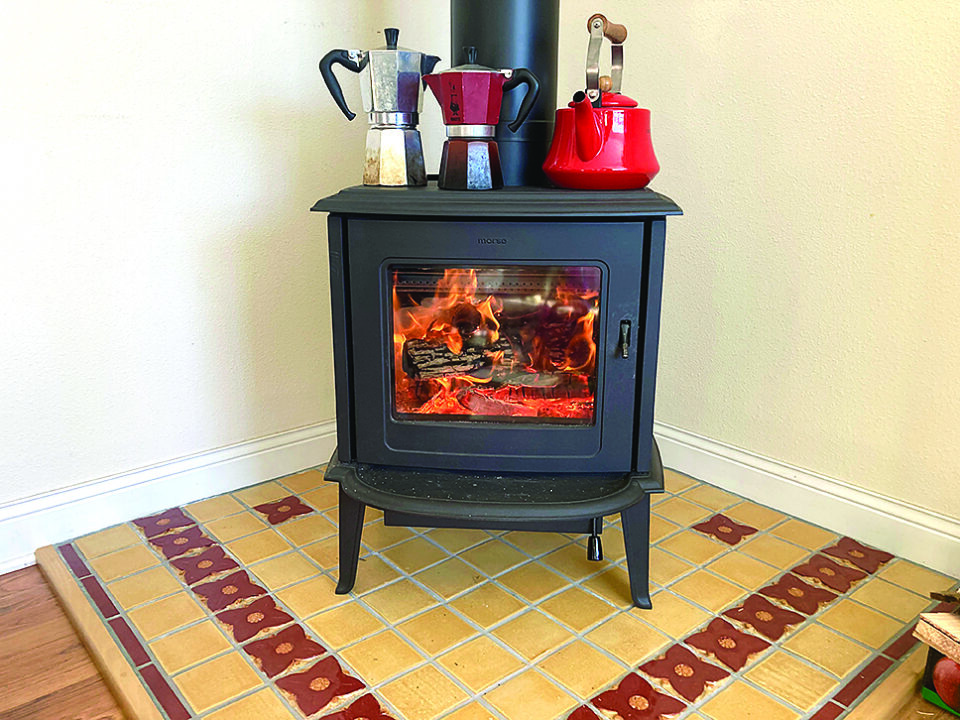The house is dark and quiet. It’s an early winter morning, or the tail end of a long workday. You strike a match and light the kindling pile you’ve prepped in the wood stove. Flames start darting to and fro, jumping and weaving from stick to stick. As the stove heats, the cast iron begins its chorus: a deep hum that envelops you, pulls you in, glues you to your chair. The iron’s constant tick ratchets up, creating a pulse, a heartbeat in the room. It sounds like a train now, running down the rails, as if the stove is moving. As the red hot bed of coals grows, the stove’s steady pace brings you back to a primitive place. Somewhere deep in our subconscious we instinctively know this soothing melody. It means safety, security, and renewal. With our homes now warmed and protected, we can embrace the basic rhythms of life.
Civil Unrest
Yet wood stoves are about more than just comfort and coziness. For today’s users, as for previous generations, a home wood stove is a mark of independence.
Rodger Holland, owner of Holland and Hearth, a Minnesota company that represents wood stove manufacturers, explains this mindset: “Wood stove sales have been really, really good. It has to do with civil unrest. It has to do with being forced into electricity, and its costs. Forcing people into electricity has not made electricity cheaper. It’s about dependability. ‘Self-reliance’ is a word that we get a lot. People just want to be a little more self-reliant.”
Holland, former chair of the national Hearth, Patio, and Barbecue Association, says customers like controlling their own home-heating destiny, no matter what it takes: “It’s that sense of security. ‘I can burn my coffee table if I want to.’”
Matt Boo and Jason May, co-owners of Duluth Stove and Fireplace, hear similar traits from some of their customers, who want to burn “my way.”
Holland adds: “People like being a little bit off the grid. There’s a sense of something primitive. Fire is very primitive. It’s something we’ve always had, and that gives a sense of security.”
This fierce independent streak gives wood stove owners the satisfaction of cranking out the heat to their own drum.
Government Regulation: An Evil, or an Opportunity?
Modern-day wood stoves have “changed entirely” from the highly inefficient stoves of the past, according to the Environmental Protection Agency (EPA). Stove manufacturers have improved their combustion technologies—the EPA left them no other choice. The EPA has steadily lowered acceptable emission levels for new stoves ever since 1988, and any home wood stoves sold since that year must have an EPA label on them. First the EPA shot for a maximum of 11 grams of particulates per hour (g/h), then the agency dropped that to 7.5 g/h in 1992. In 2015, this target was lowered to 4.5 g/h, and on May 15, 2020 (right when covid was hitting hard), the EPA reduced its standard to a miniscule 2.0 g/h of particulates.
Holland notes the effect these restrictions have had on the American stove industry over the last 36 years: “In the 1970s, during the oil embargo, there were 653 wood stove manufacturers in the U.S. Now, I think there’s about 18. The ones that folded weren’t willing to put the technology into the stove.”
Yet Holland, Boo, and May credit the EPA for taking the wood stove market to a better place. “If we could say one thing to the world, it’s that we’ve decreased our pollution by 98 percent. That’s pretty darn good,” says Holland.
That’s not to say that everybody has adopted new stoves. “There’s still lots of old wood stoves out there that people hang on to,” Holland notes.
If you’re looking to buy your own new home wood stove, now might be a good time. The federal government has incentivized wood stove purchases since 2020 by offering a tax credit of 30 percent of the cost, including installation, up to $2,000 per year for buying an EPA approved stove. The “Wood and Pellet Heater Investment Tax Credit (ITC)” is meant to get people to heat with wood—a renewable resource—rather than with fossil fuels like natural gas, propane, and heating oil.
These clean energy tax credits provide consumers with lower taxes in exchange for doing what’s right for the environment.
Your Relationship with Your Stove
One thing about owning a wood stove: you interact with it. This isn’t turning a dial on a thermostat. Lighting the fire, regulating the air intake, and adding fuel is a truly hands-on process. You will get to know your stove’s “character,” and develop a “touch” for making it burn right.
A big part of operating a stove is following the daily routines of wood burning. This includes emptying the ash pan, making kindling, bringing in wood from the outdoor pile, and cleaning the hearth regularly. Not to mention the yearly harvesting (or purchasing) of wood, as well as splitting and stacking it. This is a months-long process, year after year. For some people, this routine is a burden. For others, it’s a pleasure.
Holland calls stove owners’ daily routine their leash: “Having a wood stove is like having a dog. You’ve got to be home to feed it, and clean it, and so on.”
Of course, for those seeking a more “convenient” solution, there are gas stoves, pellet stoves, and even electric stoves available.
The Complete Package
Wood heat connects us to the very beginnings of humanity. Even today, the social aspect of having a burn with family and friends is one of wood heat’s greatest benefits.
Wood stoves heat your home, they soothe your soul, and they transport you with their dancing flames and humming sounds. They also make environmental and economic sense.
“The government is giving you an incentive to put one in,” notes Boo. “And there’s a reason for that: Wood is renewable, it’s local, it’s inexpensive, and it’s clean.”
If you’re willing to handle your fuel and follow a daily routine, the wood stove can be the best appliance in your house.






